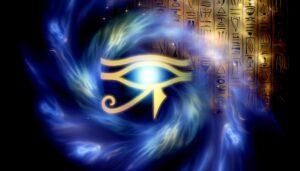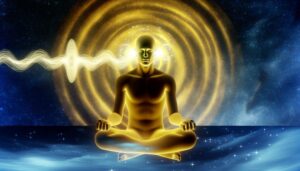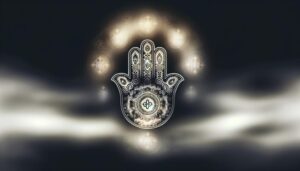Spiritual Meaning of the Eye: Awareness and Truth
The eye holds profound spiritual significance across various cultures, symbolizing divine protection, conscious insight, and the bridge between the material and spiritual domains. In Ancient Egypt, the Eye of Horus epitomizes healing and cosmic order, while the concept of the third eye in Hinduism and Buddhism represents intuition and higher consciousness.
Christian and Masonic traditions revere the All-Seeing Eye for its embodiment of divine omnipresence. The evil eye, prevalent in many ancient beliefs, serves as both a protective talisman and a symbol of malevolent energy.
This multifaceted symbol invites seekers to explore deeper spiritual truths and interconnectedness.
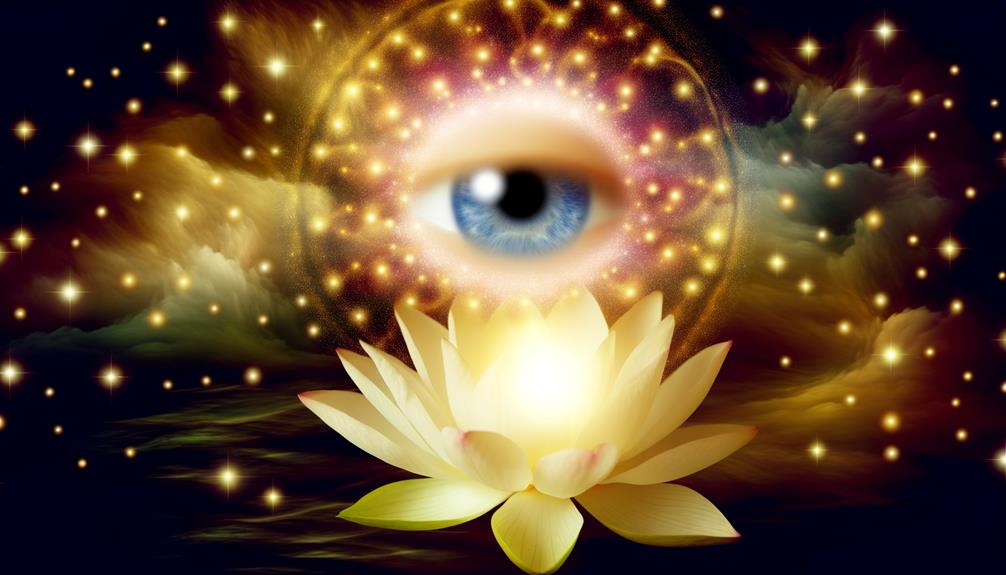
Spiritual Meaning of the Eye: Insight, Awareness, and Divine Vision
| Symbolic Aspect | Spiritual Interpretation |
|---|---|
| Inner Vision | Represents insight, intuition, and spiritual clarity |
| Divine Awareness | Connection to higher knowledge and consciousness |
| Protection | Wards off negativity and shields the soul |
| Soul Window | Seen as the gateway to one’s inner truth and emotional state |
| Enlightenment | Symbolizes awakening, wisdom, and universal understanding |
The Eye in Ancient Egypt
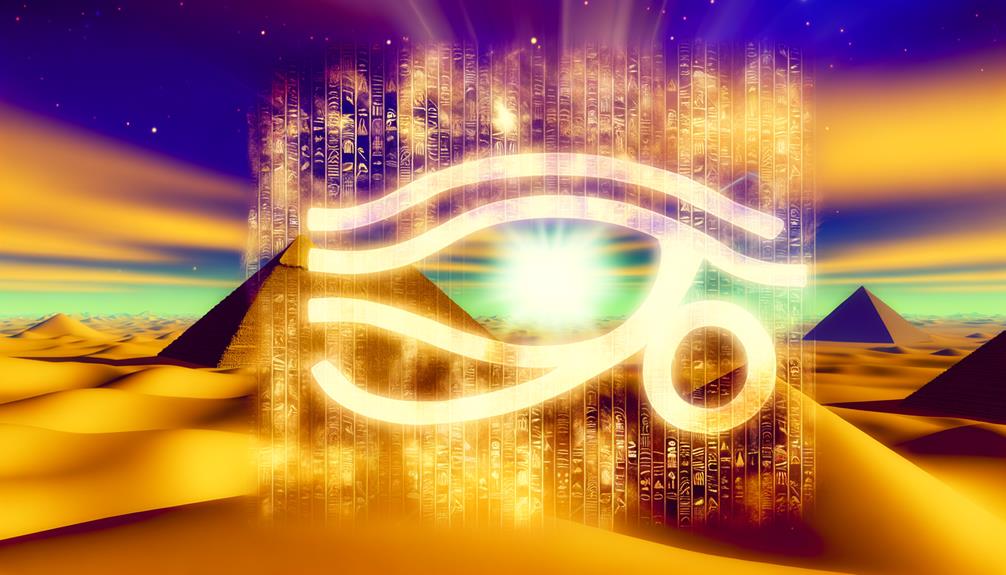
In the domain of Ancient Egypt, how did the eye come to symbolize divine protection and cosmic insight?
The Eye of Horus, also known as Wadjet, encapsulates profound spiritual meaning. It represents the all-seeing eye, a conduit to divine wisdom and omnipresence.
Symbolizing restoration and healing, it was believed to possess protective powers, safeguarding the soul on its eternal journey. The eye’s intricate imagery, often adorning amulets and tombs, reflects the Egyptians’ deep-seated reverence for cosmic order and divine justice.
This sacred symbol transcends mere artistic representation, embodying the interconnectedness of the spiritual and material spheres. Consequently, the Eye of Horus serves as a mystical beacon, guiding believers toward enlightenment and safeguarding the harmony of the universe.
The Third Eye Concept
Building upon the ancient reverence for the eye as a symbol of divine protection, the concept of the Third Eye emerges as a profound metaphor for spiritual awakening and inner vision. This mystical eye, often associated with the pineal gland, represents an elevated state of consciousness and the ability to perceive beyond ordinary sight.
| Aspect | Description |
|---|---|
| Location | Forehead, between the eyebrows |
| Associated Chakra | Ajna (Brow) Chakra |
| Symbolism | Intuition, insight, enlightenment |
| Cultural References | Hinduism, Buddhism, New Age spirituality |
| Activation Practices | Meditation, mindfulness, yoga |
Through the Third Eye, seekers aim to transcend the material world, accessing deeper truths and universal wisdom hidden from the physical domain.
The Eye in Christianity
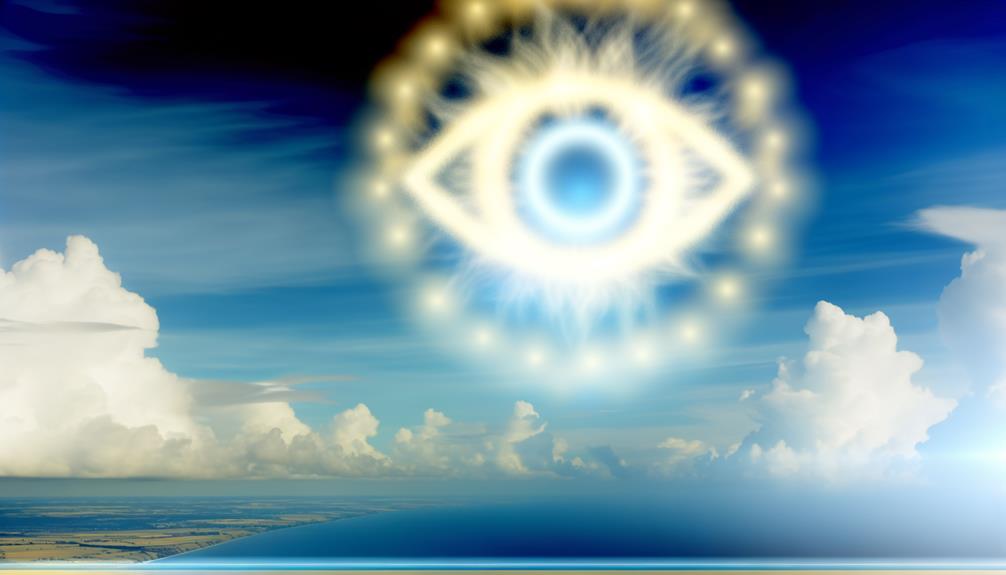
The eye in Christianity symbolizes divine omniscience and the presence of God, often represented as the all-seeing eye that watches over humanity with infinite wisdom and care.
This sacred imagery, frequently depicted within the confines of a radiant triangle, signifies the Holy Trinity and God’s eternal vigilance. It serves as a poignant reminder of an omnipresent deity who observes all actions, thoughts, and intentions, offering both guidance and protection.
Reflecting on this symbol invites believers to cultivate a deeper sense of accountability and spirituality, acknowledging the divine gaze that permeates every aspect of existence.
Through this mystical lens, the eye becomes a beacon of divine insight, urging the faithful to align their lives with higher moral and spiritual principles.
The Evil Eye Belief
The belief in the Evil Eye, a powerful and ancient notion, traverses various cultures and epochs, reflecting a shared human concern for unseen malevolent forces.
Rooted in rich traditions, it has inspired the creation of protective symbols and talismans, each bearing unique cultural imprints.
In contemporary times, this belief continues to evolve, manifesting in modern interpretations and practices that echo its mystical origins.
Origins and Cultural Significance
Ancient civilizations, spanning from Mesopotamia to Greece, imbued the concept of the evil eye with profound cultural significance, attributing both protection and malevolence to its gaze.
The belief in the evil eye is a universal thread weaving through the tapestry of human history, a mystical acknowledgment of the eye’s perceived power. In Mesopotamia, it was thought to bring misfortune, while in Greece, it was a potent symbol of envy and harm.
This duality reflects a deep-seated awareness of the eye as a window to the soul, capable of both blessing and curse. Such beliefs underscore the ancient understanding of unseen energies and human interconnectedness, a proof to the enduring mystique surrounding the gaze that could heal or harm.
Protective Symbols and Talismans
Across diverse cultures, the belief in protective symbols and talismans, particularly those guarding against the evil eye, reveals a profound recognition of the unseen forces influencing human existence.
These mystical emblems, such as the Nazar amulet or Hamsa hand, serve as shields against malevolent stares believed to harbor envy or ill will.
Rooted in ancient traditions, these symbols embody a collective consciousness that perceives the eye not merely as a physical organ but as a conduit for spiritual energy.
The evil eye belief underscores the interplay between human emotions and metaphysical domains, prompting communities to seek harmony and protection through these revered talismans.
Consequently, they weave a tapestry of cultural wisdom, bridging the tangible world with the mystical.
Modern Interpretations and Beliefs
In today’s interconnected world, the belief in the evil eye continues to resonate, manifesting in both traditional practices and contemporary interpretations. This ancient concept, which posits that a malevolent glare can cause misfortune, is now interwoven with modern spirituality and psychological awareness.
The evil eye belief finds expression in various forms:
- Amulets and Jewelry: People wear protective symbols, such as the Nazar, to ward off negative energies.
- Cultural Assimilation: The belief has permeated diverse cultures, adapting to local customs and practices.
This enduring belief, steeped in mystical traditions, continues to offer a profound lens through which to view human interactions and vulnerabilities.
The All-Seeing Eye
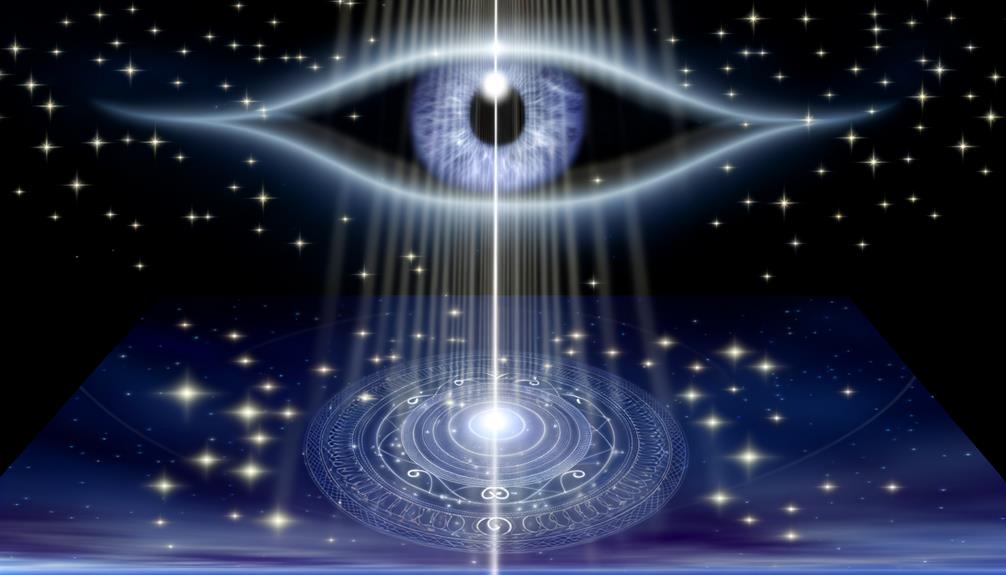
The All-Seeing Eye, a potent emblem transcending cultural boundaries, signifies an omnipresent awareness that bridges the earthly and the divine.
This symbol, revered in various traditions, embodies the pursuit of higher consciousness and spiritual enlightenment.
Its gaze encourages us to seek a deeper connection with the universe and our place within it.
Symbolism in Various Cultures
Throughout history, the All-Seeing Eye has emerged as a potent symbol of divine omniscience and protection, transcending cultural boundaries and resonating with a shared human quest for understanding the unseen. This enigmatic symbol appears in diverse traditions, each attributing unique meanings while reflecting universal motifs.
- Ancient Egypt: The Eye of Horus epitomizes healing and restoration, an emblem of Ra’s celestial vigilance.
- Freemasonry: The Eye within a triangle signifies the watchful eye of the Great Architect, overseeing moral conduct.
These representations underscore the profound spiritual significance of the All-Seeing Eye, bridging the tangible and the mystical across cultures.
Connection to Higher Consciousness
Delving into the enigmatic All-Seeing Eye reveals its profound connection to higher consciousness, serving as a portal to deeper spiritual awareness and enlightenment.
This ancient symbol, often depicted as an eye within a triangle, represents the omnipresence of a divine entity observing and guiding the universe. It invites individuals to transcend the material domain, accessing higher states of awareness and inner wisdom.
Within this mystical gaze, one finds the confluence of intuition, insight, and universal truth, prompting a journey toward self-realization and unity with the cosmos.
The All-Seeing Eye consequently stands as a beacon, urging seekers to awaken their latent spiritual faculties and embrace a more profound, interconnected existence.
The Eye in Art
In various artistic traditions, the eye often emerges as a profound symbol of perception, insight, and spiritual vision. Artists have long employed the eye to convey deeper truths, inviting viewers to explore the unseen domains of consciousness. The eye is not merely a physical organ but a gateway to the soul, a lens through which hidden layers of existence are revealed.
- Ancient Egyptian Art: The Eye of Horus represents protection, royal power, and good health.
- Renaissance Art: The eye often symbolizes divine omniscience and human intellect.
These artistic expressions reflect humanity’s quest to understand the mysteries of existence through the sacred lens of the eye.
Modern Spiritual Interpretations
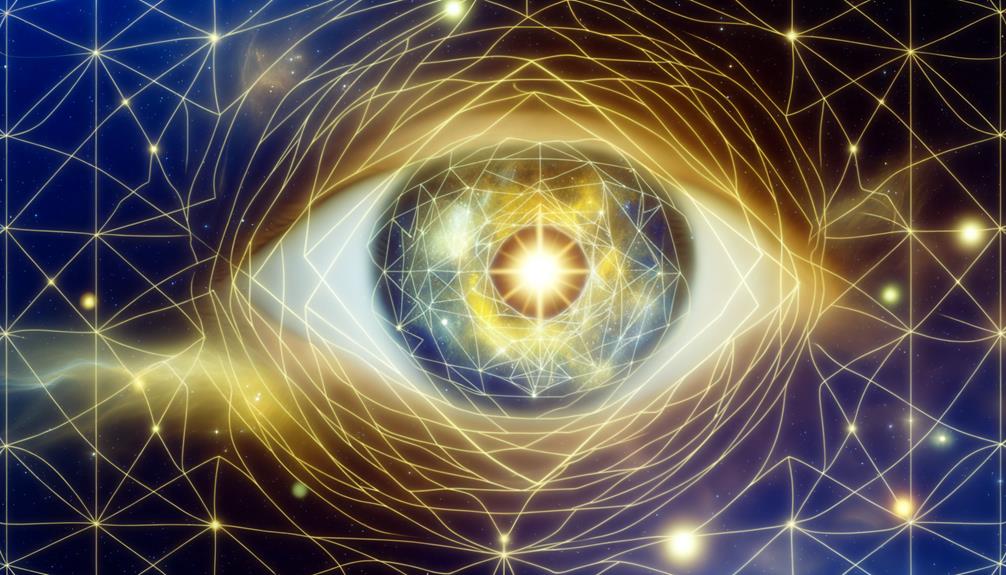
Modern spiritual interpretations of the eye continue this ancient tradition, imbuing it with meanings that resonate deeply in today’s quest for enlightenment and self-awareness. The eye is often seen as a portal to the soul, reflecting inner truths and guiding seekers toward higher consciousness.
In contemporary spiritual practices, the eye symbolizes intuition, clarity, and the ability to perceive beyond the physical domain. It serves as a reminder of the interconnectedness of all beings and the importance of inner vision in maneuvering life’s complexities.
Meditative practices frequently emphasize the ‘third eye’ chakra, believed to enhance spiritual insight and intuition. Consequently, the eye remains a powerful emblem, bridging ancient wisdom with modern spiritual awakening.
Conclusion
The eye, a potent symbol across cultures and epochs, embodies profound spiritual significance.
Ancient Egyptian reverence for the Eye of Horus, the mystical concept of the third eye, Christian iconography, and the pervasive belief in the evil eye illustrate its diverse interpretations.
The all-seeing eye, its depiction in art, and modern spiritual reinterpretations further underscore its enigmatic presence. This exploration reveals a universal, timeless quest for deeper insight, protection, and divine connection through the emblematic eye.

